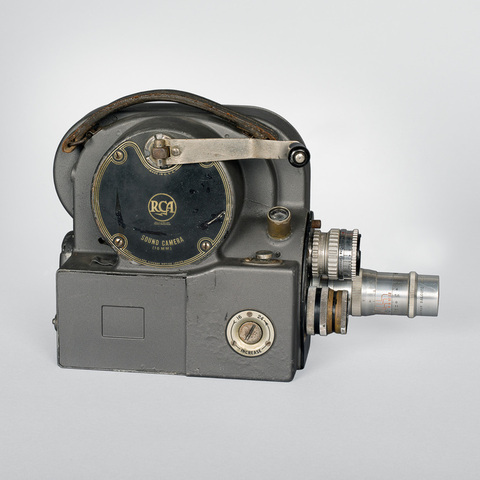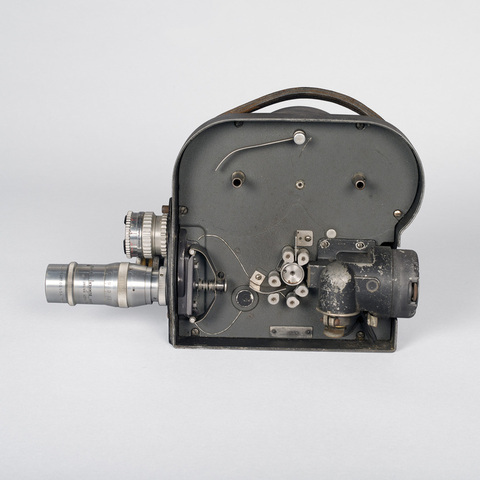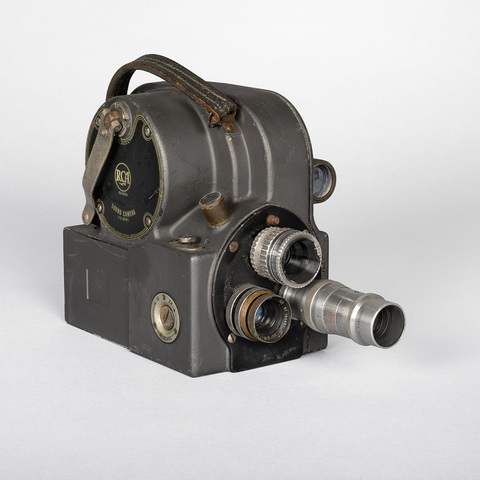Caméra film 16 mm sonore
Fiche détaillée
Type de l'appareil
entraînement du film 16 mm par une griffe ; un débiteur denté entouré de six galets ; emplacement intérieur pour une bobine débitrice et une bobine réceptrice ; enregistrement du son optique sur pellicule ; ampoule électrique ; moteur électrique ; galvanomètre à miroir enregistreur ; emplacement pour microphone ; tourelle à trois objectifs ; manivelle ; viseur sur la porte ; viseur pour objectif ; vitesse 16 ou 24 images seconde ; emplacement pour trois piles; poignée cuir
Auteurs
Informations non disponibles
Fabricants
RCA Victor Company Inc.
Camden, New Jersey
Utilisateurs
Informations non disponibles
Distributeurs
RCA Victor Company Inc.
Camden, New Jersey
Sujet du modèle
Informations non disponibles
Objectif
Kodak Cine Ektanon Lens 15 mm f. 2.7 Made in USA by Eastman Kodak Co., Rochester N.Y. Bausch & Lomb Opt. Co. USA 75 mm f. 3.5 Tele-Animar Balcote Switar 1:1,4 f= 25 mm AR n° 169 857
Taille de l'objet
Ouvert :
Informations non disponibles
Fermé :
Longueur : 30 cm
Largeur : 14 cm
Hauteur : 19 cm
Diamètre :
Informations non disponibles
Taille de la boîte de transport
Informations non disponibles
Remarques
Marques : "Made in U.S.A. RCA Reg. U. S. Pat. Off. Marca registrada. Sound camera (16 mm). See license notice inside" ; "RCA Sound Camera Type PR - 25. U.S. Patents 1 203 190, 1 213 613. [...] RCA Victor Company, Inc., Camden, N.J., U.S.A.".
"You look through the finder, you press the button. That gets your picture. At the same time, you talk into the mouth-piece. That gets your sound. When the film comes back to you from the processing station both will be permanently recorded, ready for screening. But you don't have to keep the "electric ear" which picks up the sound directly fastened to the camera, nor do you have to limit your sound recording to your own voice, for this is really two cameras in one. [...] Recording mouthpiece. A circular opening under the finder eyepiece at the rear of the camera contains the removable newsreel unit. This is a small diaphragm assembly complete in itself. When in place, it presents a screened mouthpiece located in a convenient position for speaking in an ordinary tone of voice, while the camera is held in operating position. The unit is easily detached by means of unloosening four screws (no electrical connections) and replacing with the studio attachment which records the voice or sound of the subject. [...] Dry cell operation. Only three small inexpensive dry cells of the flash-light type are needed to energize the recording lamp for newreel shooting. No other electrical connections, batteries or amplifiers will be needed to produce sound movies by this system, which is truly flexible, portable and efficient. One set of batteries will last 500 feet of film" (RCA completes the picture with sound, Camden, RCA Victor Co., s.d.).
"At last ! A simple home talkie camera. New R.C.A. instrument announced. Although not the first 16 mm sound-on-film camera - the English Marshall and the American Berndt have already been described - the new R.C.A. model is the first model to be designed specifically for home use. Those behind the scenes have known for some time of a coming R.C.A. sound camera for 16 mm users, and a few details have leaked out from time to time. "Home movies" has not obtained full particulars and illustrations of this instrument, and we lose no time in describing it. In general appareance it does not greatly differ from existing silent cameras of the turret type, although its base is a little wider. As will be seen, it is designed to take three rapidly interchangeable lenses, with a viewinder of the spy-glass type. Although we notice that the optical separation between the centre of the finder and the centre of the taking lens is greater than usual, this parallax effect is fully compensated in the eyepiece. Accurate focusing of the camera is allowed for the provision of means of fitting a critical focusing device, the plug for which can be just seen behind the turret on the left of the camera. This focuser is not provided in the standard instrument, but can be purchased later as an extra. A universal fixed focus f 3.5 lens is furnished with the camera and others can be added as desired, the mounts being standard. As many purchasers will already have a silent camera fitted with standard lenses this point of interchangeability is a decided advantage. There is the usual spring drive and a two-speed adjustment allows silent pictures to be taken at 16 frames a second or talkies at 24. Such conventional fittings as winding-handle, spring-driven motor, footage indicator, etc., call for no special comment. The chied ingenuity of this instrument lies in the fact that there are two ways of using it for sound work. First of all, it can be used as a self-contained unit in the hand, without trailing wires or other external connections provided the user whises to confine himself to his own voice, for the camera is so designed that when the viewfinder is held to the eye an aperture into which the user can speak comes near the mouth. Recording is effected by the variable area method, the recording light coming from a lamp operated from the small flashlight batteries inside the body. The recording mirror is operated acoustically in this case, thus saving a great deal of complication, space and extra batteries. This arrangement is called the "News Reel Model", the idea being, of course, that the user can make a running commentary on what he is taking. In our opinion, there will not be a great demand for the camera with this limitation, and we are more interested in the "Studio Model", which is really the "News Reel Model" with additional accessories consisting of a separate battery case, an amplifier and a microphone. The conversion is achieved by placing the news reel model on a stand on each side of which hang the two cases shown, supporting the battery and amplifier. The acoustically-operated recording device is removed and for it substituted a galvanometer, the small batteries inside being then eliminated. A cable runs from the camera to the amplifier and battery case and thence to the microphone, which is of the magnetic type and can be situated at any distance from the camera so long as it is suitably placed for the sound. The camera records on reversal film of a special fine-grain type evolved for the purpose and having, as it usual in substandard sound work, a row of perforations on one slide only. Picture and sound are recorded simultaneously and the film is sent for processing in the normal way, the cost being no higher than that of ordinary reversal film. Everything has been done to simplify operating. For example, the amplifier is fitted with a multiwire plug which cannot be wrongly inserted, thus preventing connections being incorrectly made, while provision is also made for plugging a telephone headpiece so that the user can judge whteher the strenght of sound is correct for recording. The volume control, of the kind used in wireless sets, is used to vary the level of sound and a glow light is provided as a check during recording. Two valves are used in the amplifier. Threading the camera is particulary easy, there being only one sprocket together with four "idlers" - only two more than a silent camera with a similar form of propelling mechanism. By the use of these additional idlers the speed of the film is made perfectly uniform by the time it reaches the smal opening through which the beam of recording light is projected. Both Kodak and Agfa have announced special film for this camera, and no doubt with suitable emulsions and fine-grain development negative-positive can also be used. The price of the instrument has not yet been announced for this country, but it will probably be in the region of £ 150 for the studio model" (Home Movies & Home Talkies, novembre 1934, p. 223-224). (La caméra sera distibuée en Grande-Bretagne par la RCA Photophone LTD, London, Home Movies & Home Talkies, December 1935, p. 297).
"La première caméra 16 mm à enregistrement sonore est sortie... Un prix modique, 4000 fr pour le modèle autographique à membrane sonore, 7000 fr pour le modèle à galvanomètre enregistreur. [...] L'enregistrement sonore n'a nécessité l'adjonction que de trois éléments : une tête d'enregistrement à organe sensible (microphone direct à membrane, ou galvanomètre à palette), un coffret à piles pour l'alimentation de la lampe d'enregistrement, un système particulier de 6 galets entourant le débiteur denté. La tête d'enregistrement est emmanchée à l'arrière de la caméra, présentant ainsi l'embouchure du micro (dans le cas du type autographique) en-dessous du viseur devant la bouche de l'opérateur, et elle projette la fente lumineuse modulée sur la portion de film qui entoure le secteur arrière du débiteur denté. Les piles qui chauffent le filament de lampe (4 V - 0,8 A) sont logées dans un logement côté droit de la caméra. Le film venant de la bobine débitrice passe sous deux galets qui le font engrener d'un quart de tour à l'avant du débiteur : après une boucle, la bande sensible s'engage dans le couloir de prise de vue, reforme une seconde boucle, passe sur deux galets amortisseurs, et est enfin réappliquée sur un quart de tour à l'arrière du débiteur au moyen des deux derniers galets ; la technique des galets fixes a été adoptée comme sur la plupart des appareils américains. Il ne faut naturellement pas demander à un système aussi simple une qualité d'enregistrement exceptionnel : le domaine des fréquences enregistrées est limité à la gamme 200-3000 p.p.s.... et cela peut suffire avec une excellente modulation. Tous les efforts des techniciens de RCA ont donc porté sur les systèmes vibrants et sur les dispositifs d'amplifications : dans le type autographique, une membrane métallique plissée actionne le miroir de déviation du rayon lumineux par un système de leviers fort légers en équilibre dynamique parfait ; dans le type à galvanomètre, les sons sont captés par un micro électromagnétique et amplifiés par un ampli à deux lampes ; l'ampli et les batteries d'alimentation sont renfermés en deux boîtes suspendues de chaque côté du pied tripode de la caméra. La mise en vente sur le marché de cette caméra sonore offre certainement un nouveau débouché au cinéma d'amateur, notamment avec le système autographique ; mais attention, il ne suffira plus d'être un bon opérateur, il faudra savoir parler et savoir improviser le reportage des scènes filmées : à l'entraînement, messieurs les amateurs cinéastes-speakers !" (Jean Vivié, "La première caméra sonore (RCA Victor Cy)", Ciné-Amateur, n° 42, novembre 1934, p. 19-20).
Bibliographie
RCA completes the picture with sound, Camden, RCA Victor Co., s.d.
Jean Vivié, "La première caméra sonore (RCA Victor Cy)", Ciné-Amateur, n° 42, novembre 1934, p. 19-20.
Home Movies & Home Talkies, novembre 1934, p. 223-224.
Home Movies & Home Talkies, March 1935, p. 405.
Home Movies & Home Talkies, April 1935, p. 451.
Home Movies & Home Talkies, December 1935, p. 297.
Home Movies & Home Talkies, June 1937, p. 18.
Cinéma pour tous, n° 4, décembre 1937 ; n° 19, avril 1939.


